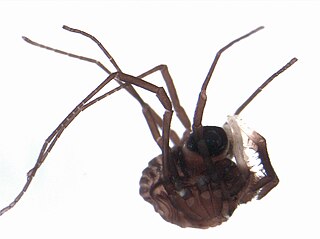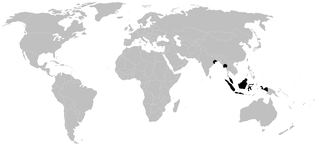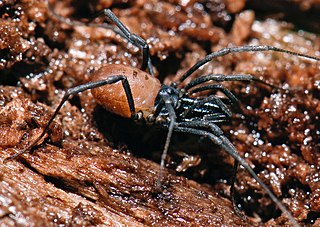
The Opiliones are an order of arachnids colloquially known as harvestmen, harvesters, harvest spiders, or daddy longlegs. As of April 2017, over 6,650 species of harvestmen have been discovered worldwide, although the total number of extant species may exceed 10,000. The order Opiliones includes five suborders: Cyphophthalmi, Eupnoi, Dyspnoi, Laniatores, and Tetrophthalmi, which were named in 2014.

Sabacon is a genus of the monotypic harvestman family Sabaconidae, with 59 species.

Caddoidea superfamily of harvestmen arachnids with a single family Caddidae, which now only contains 2 extant species. The family previously contained many more taxa under a previous wider concept, but the familial definition was narrowed after restudy.

The Stylocellidae are a family of harvestmen with about 40 described species, all of which occur in Southern or Southeastern Asia. Members of this family are from one to seven millimeters long. While Stylocellus species have eyes, these are absent in the other two genera.

Dalquestia is a genus of harvestmen in the family Globipedidae with six described species. All species are found in North America.

Protolophus is a genus of harvestmen in the family Protolophidae from the Western US.
Buresilia is a genus of harvestmen in the family Phalangiidae with three described species. The species are found in West Asia, Anatolia and Cyprus.

Taracus is a genus of harvestman, or Opiliones, typically found living in limestone and lava caves in the United States. They grow to a size of 2.0–5.5 mm (0.08–0.22 in).

Taracidae is a family of harvestmen in the order Opiliones. There are 4 genera and 23 described species in Taracidae.
Cladolasma, is a genus of harvestmen belonging to the family Nemastomatidae. The genus is monotypic containing a single species Cladolasma parvulum. They are endemic to Japan, with records in Ehime and Tokushima Prefectures. The genus was described by Seisho Suzuki, with the type species Cladolasma parvulum Suzuki, 1963, subsequently revised to Dendrolasma parvulum in Suzuki (1974), but later restored as a valid genus.

Caddo is a genus of harvestmen in the family Caddidae. There are two described species in Caddo. Both species are found in North America and Eastern Asia.

Ortholasma is a genus of harvestmen in the family Nemastomatidae with 5 described species. The genus has been revised by Shear (2010).

Dendrolasma is a genus of harvestmen in the family Nemastomatidae with two described species. Both species are found in the western coast of North America. An overview of their taxonomy was provided by Schönhofer (2013).

Acropsopilionidae is a family of harvestmen with 19 described species in 3 genera.

Ortholasmatinae is a subfamily of harvestmen in the family Nemastomatidae with 27 described species in 7 genera. They are found in temperate and often mountainous regions of the Northern Hemisphere.

Nemastomatinae is a subfamily of harvestmen with over 125 described species in 19 (extant) genera. They are usually found in temperate regions.

The harvestman family Globipedidae is a small lineage comprising 6 genera and some 34 species from North America and Central America, formerly included as a subfamily within Sclerosomatidae.
Asiolasma is a genus of harvestmen in the family Nemastomatidae with six described species . The species are found in Southeast Asia, namely China, Vietnam and Thailand. Some species are treated under other genera in Schönhofer (2013).
Trilasma is a genus of harvestmen in the family Nemastomatidae with nine described species . The species are mainly found in Mexico.

Rakaia is a genus of harvestmen in the family Pettalidae with eighteen described species. All species are found in New Zealand.












